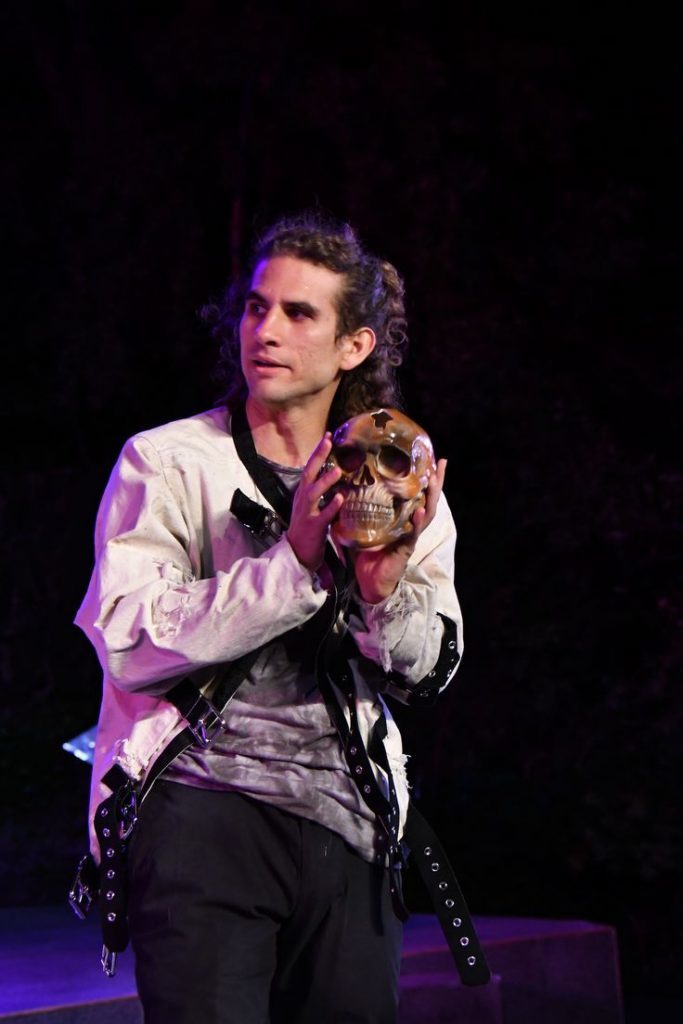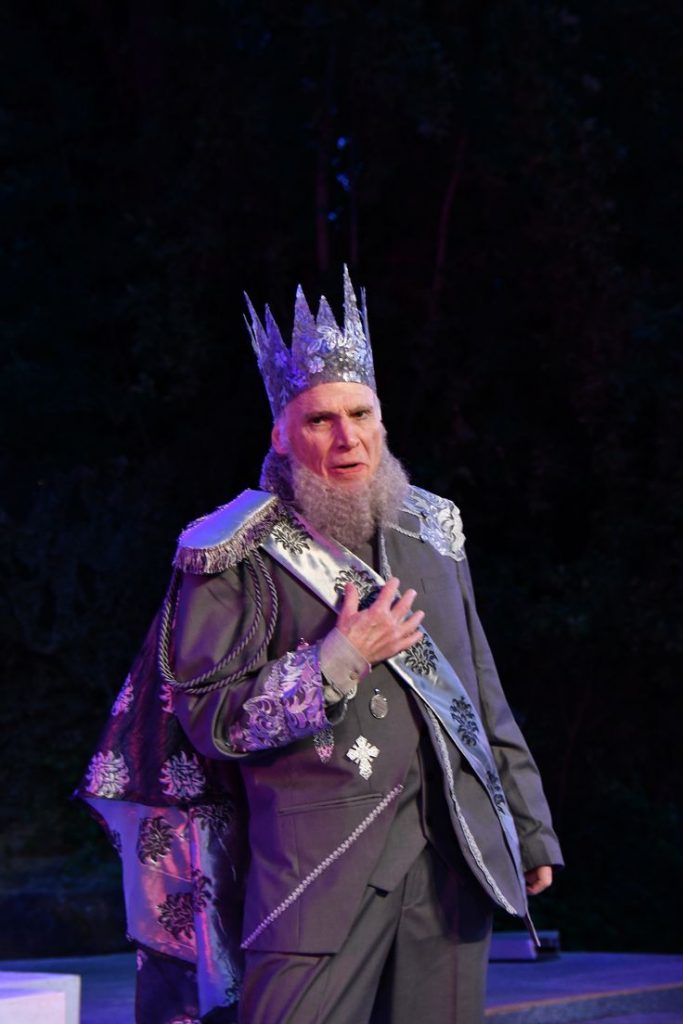Free Resources for teaching and learning about A Midsummer Night’s Dream online.
March 28, 2020 § Leave a Comment
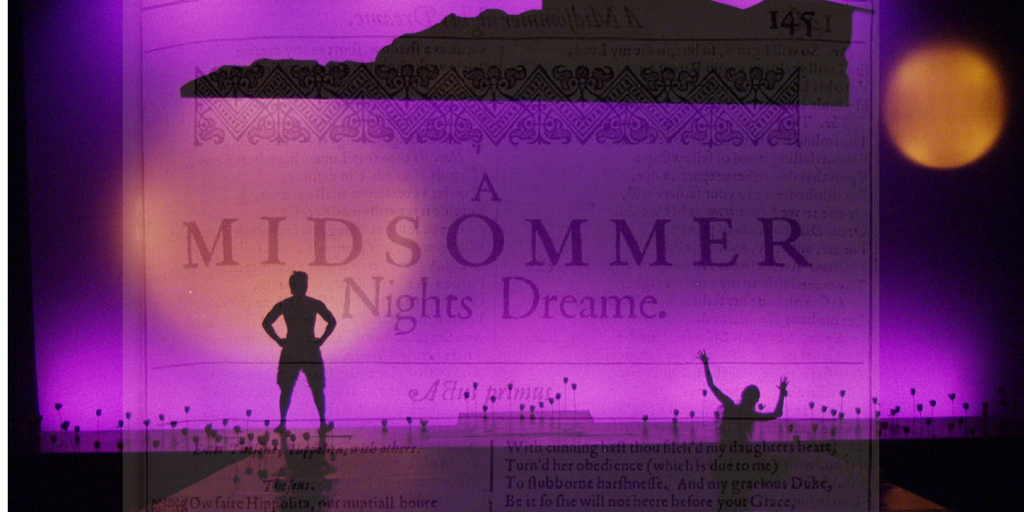
Education at Home
It is March 2020, and I (like many people throughout the world) am sheltering in place in my home, trying to help flatten the curve of Covid-19. I am also teaching and learning almost exclusively online. Although our times are difficult, learning about Shakespeare does not have to be. Since a focus of my study has been A Midsummer Night’s Dream for several years now, I wanted to share some of my work and some of my favorite tools for exploring and enjoying the play, since it is widely assigned as an introduction to Shakespeare.
A New Online Edition
My contribution is a digital edition of the play, which you can find here:
The Players’ Reference digital edition of Midsummer
You can see a short (8 minute) video Quick Start Demo of the edition here that quickly explains why it is easy (and I hope fun) to use:
This edition has the complete text, fully glossed and annotated to explain both meaning and context, along with modes to help you speak it aloud and to practice speeches or roles you may be memorizing. It also contains useful summaries of the text and performance histories, and an essay on the way Shakespeare uses music and dance to tell the story.
My Favorite Resources
While doing my research, I ran across a number of other free tools that helped me get to know the play better, and which any student (or teacher, or parent) might also find helpful and enjoyable.
A particular favorite of mine is Akiva Fox’s brilliant Clear Shakespeare Read-Along Podcast
which I previously reviewed here on Shakespeare’s Tribe in greater detail:
You might also find audio recordings of the play helpful because you can read along while listening to them. Here are two good ones:
Folger Library Audio Recording of Midsummer, (streaming for free until July 1, 2020)
and
BBC Radio 3’s Audio Recording of Midsummer
Interestingly, I often find video and film productions less helpful when studying the script, because they demand your full attention and you can’t really attend to the text while watching them. Also, most versions that I know cut and rearrange the text extensively to create an experience more like contemporary film or television. That is not so helpful. Still, it IS useful to have an idea of how a production might look and feel. Here is a nice fifteen minute excerpt from a production at Shakespeare’s Globe in London that gives a sense of what an Elizabethan performance might have looked like.
Some Updates
The Royal Shakespeare Company has a great “Learning Zone” page dedicated to MND, from which you can access three levels of information (new to the play, intermediate and advanced) especially designed for home schooling, divided into four sections on story, characters, language and staging.
CalShakes (The California Shakespeare Theatre), local to me in the San Francisco Bay Area, has made a number of their study guides available for free for the spring including a nice one about their 2019 production of MND. You can open it, then read it here. I especially like a teen-friendly description of the plot and a nice graphic on character relationships included in it.
Finally, Shakespeare’s Globe Theatre in London has announced that they are making their entire Globe-to-Globe library of international productions available for free on their streaming platform, Globe Player, this spring, starting April 6. There is a fascinating Korean adaptation of MND in that group.
They are also making a selection of some of their most famous productions, starting with Hamlet available for two week periods each. Their 2013 production of Midsummer, staged by their then-artistic direct Dominic Dromgoole and starring their current artistic director Michelle Terry as Titania, will be available May 4-17. This is the full production from which the Oberon/Puck section was excerpted above.
Your Library Can Help
I can’t currently find any high quality, full-length productions that are easily available for free, but I am able to access Julie Taymor’s excellent film through my university’s library through two different sources, Films on Demand and ProQuest’s Alexander Street. If you do want to watch a film version you might check with your library’s online or telephone help desks to see if they offer streaming video services. A lot of them do, and during this time that so many of them have facilities that are physically closed, they are making virtual resources more widely available.
Over-incarceration. Measure for Measure at Marin Shakes
July 7, 2019 § Leave a Comment
Our traumatized times speak eloquently to and through Robert Currier’s production of Measure for Measure for the Marin Shakespeare Company, which opened their thirtieth season on Saturday, June 28.
Until recently, MM was relatively rarely performed. In our #MeToo moment, however, its two abused and disbelieved heroines suddenly look a great deal more relevant, making the play something of the current Shakespeare champion.
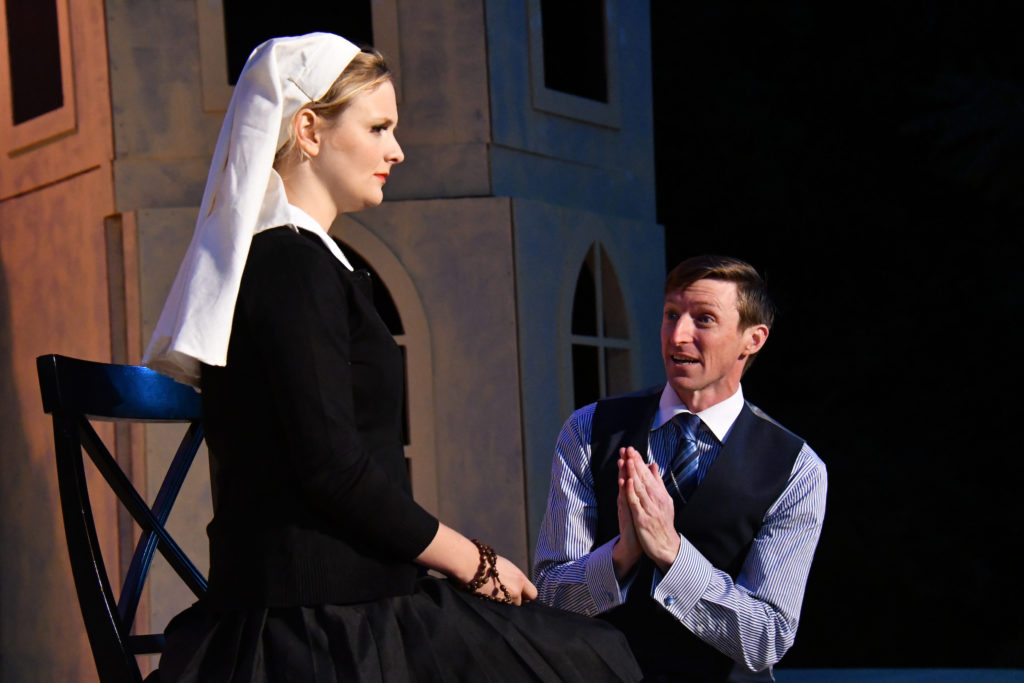
Social Injustice Everywhere You Turn
But sexual harassment is just a small part of the social injustice Currier targets. The production also speaks to abuse of power, official corruption, passive acquiescence to intolerable behavior even by those with troubled consciences, racism, religious hypocrisy and, more directly than anything else, the terrible blight of over-incarceration that results from a toxic mix of all these ills.
Currier and the company he co-leads (with his wife, Lesley Schisgall Currier) certainly have the moral authority to make the statements they are making. Despite being a relatively small company, Marin Shakes is the largest provider of Shakespeare in Prison projects in the world, working in over a dozen California prisons. Among them is San Quentin (where this production is recognizably placed by set designer Jackson Currier, prop designer Joel Eis and costume designer Tammy Berlin) which sits about five miles from the theatre in San Rafael where the production is performed. One formerly incarcerated performer makes his professional debut in this production, while another is an artist-in-residence (and much awarded performer) with the company.

This exposure clearly informs the setting and performance of the numerous prison scenes in the production. The play’s plot traces the fortunes of a young man, Claudio, who is sentenced to death for impregnating his fiancé before marriage by an overzealous, and (it turns out) hypocritical judge. Ordinarily, the interest in the play turns to the incarcerated man’s sister (a novice on the verge of becoming a nun) who pleads for his case to the judge, who promptly propositions her. Claudio becomes a minor character. In this case, however, Claudio’s cell is situated in the down right corner of the stage, and he is continuously visible for almost the entire play. Brennan Pickman-Thoon brilliantly keeps his character on our minds without ever stealing focus or upstaging the main action. His concentrated performance, however, reminds us how much injustice is being perpetuated simply because it is “out of sight, and out of mind.”
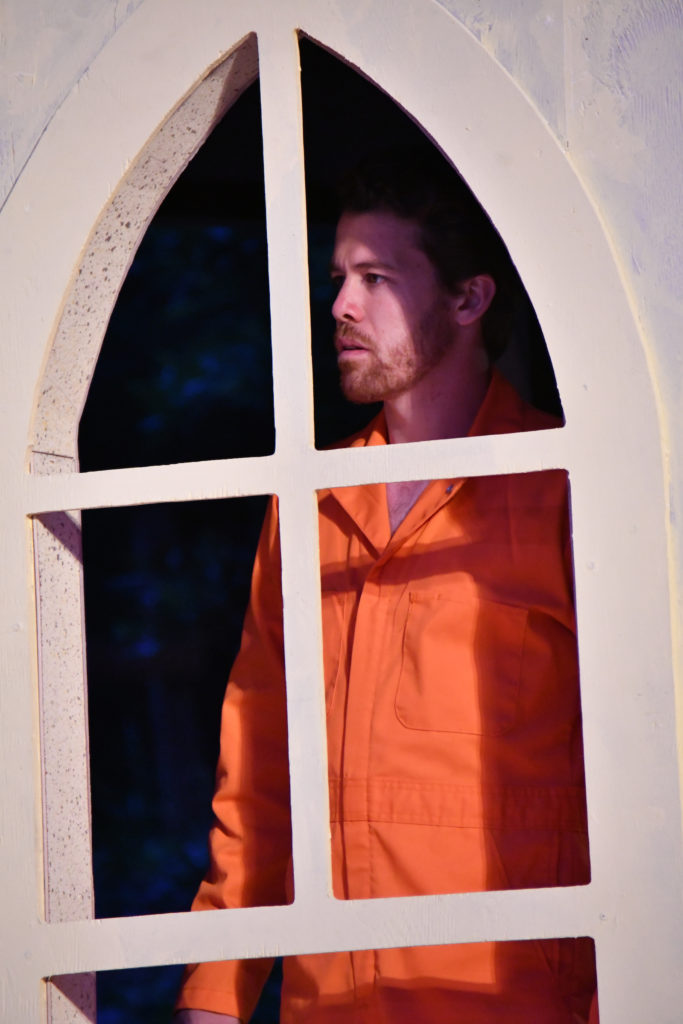
When his sister Isabella (played by Luisa Frasconi) visits, the waiting room walls chillingly host what appears to be real warnings from the corrections department that “staff and visitors will not be considered hostages for bargaining purposes,” along with zero tolerance statements required by the Prison Rape Elimination Act. She and all others are subject to realistic electronic scans upon arrival at each and every entrance.
The purpose of her visits is to tell her brother than the corrupt judge (played by Joseph Patrick O’Malley) has offered to commute his death sentence in return for sexual favors, but she has declined. She asks, and expects, her brother to die for this principle, and brutally denounces him when he suggests that perhaps it would not be a mortal sin under these circumstances.
The Problem of a Problem Play
Currier’s production is undecided how to handle this, and several other incidents. MM, like its fellow problem play, The Merchant of Venice, is structurally a comedy, but much of it cannot be played for laughs anymore—if it ever could—and finding the right tone is difficult. On opening night the production frequently miscalculated how far to joke and temper the central—sexual harassment—scenes.
Low Comedy When Its Called For
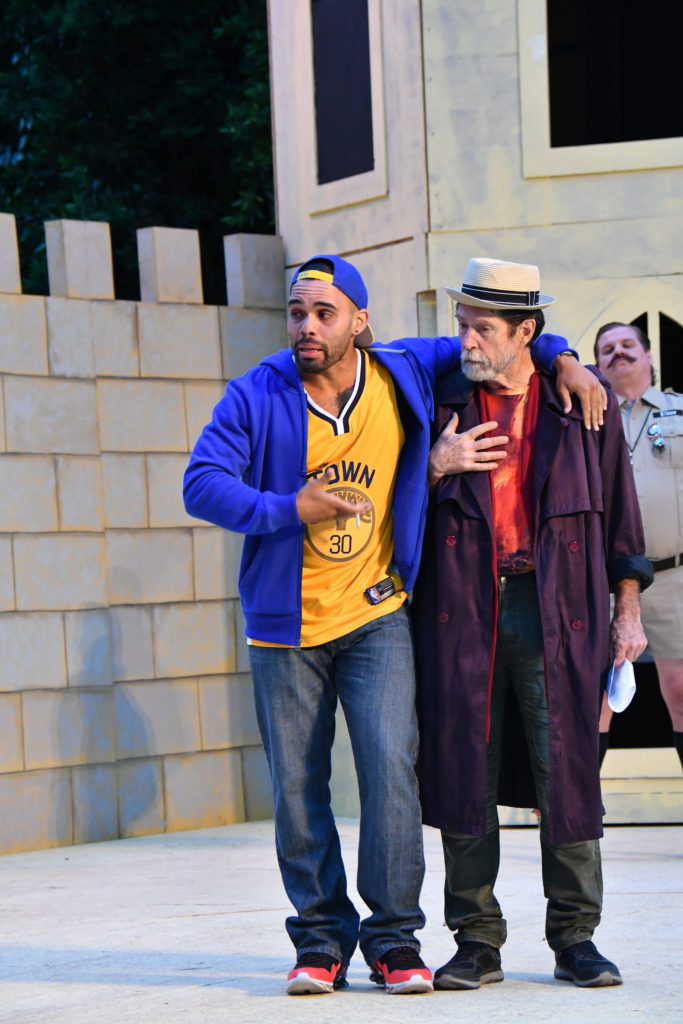
Audiences might yet steer it to a more sensitive place, especially since it doesn’t need the main characters to provide comic relief. As it is, the outstanding performances in the play are by the low comedians, especially Ed Berkeley as the pimp, Pompey, who adlibs much more than is “set down for him,” but with perfect timing and excellent deadpan delivery. Ariel Zuckerman as Lucio and Isabelle Grimm as Mistress Overdone were also very funny.
Big Impact
In the end, however, the production still found its impact. Currier has a knack for capturing the zeitgeist, and this production has the same nervous and uncertain feel that everyday life seems now to have. Without spoilers, suffice it to say that this production also declined (without changing any text) to offer the traditional reassuring ending. It was honest enough to make us question what will happen next.
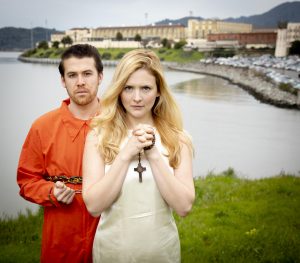
Production Information
Measure for Measureby William Shakespeare (seen, June 29, 2019)
Thursdays through Saturdays at 8 pm; Sundays at 4 pm, through July 21
Forest Meadows Amphitheatre, Dominican University of California, 890 Belle Avenue, San Rafael, CA.
Tickets: $10 – $38, 415-499-4488, www.marinshakespeare.org.
Et in ARCADIA Ego: a review of Stoppard’s ARCADIA at Berkeley’s Shotgun Players
January 2, 2019 § 1 Comment
Start Your New Year Right!
I saw a lot of great theatre in 2018 from all over the world, and will be writing a bit more about it here soon. However, if you are looking for a bit of good news to launch the new year, look no further than the announcement that one of my top ten picks is still available! Patrick Dooley’s sublime production of Tom Stoppard’s Arcadia has extended through Jan 27 at Shotgun Players in Berkeley. For those who love the theatre of words and ideas, Stoppard’s play is always a treat, but Dooley’s production exceeds expectations in every way.
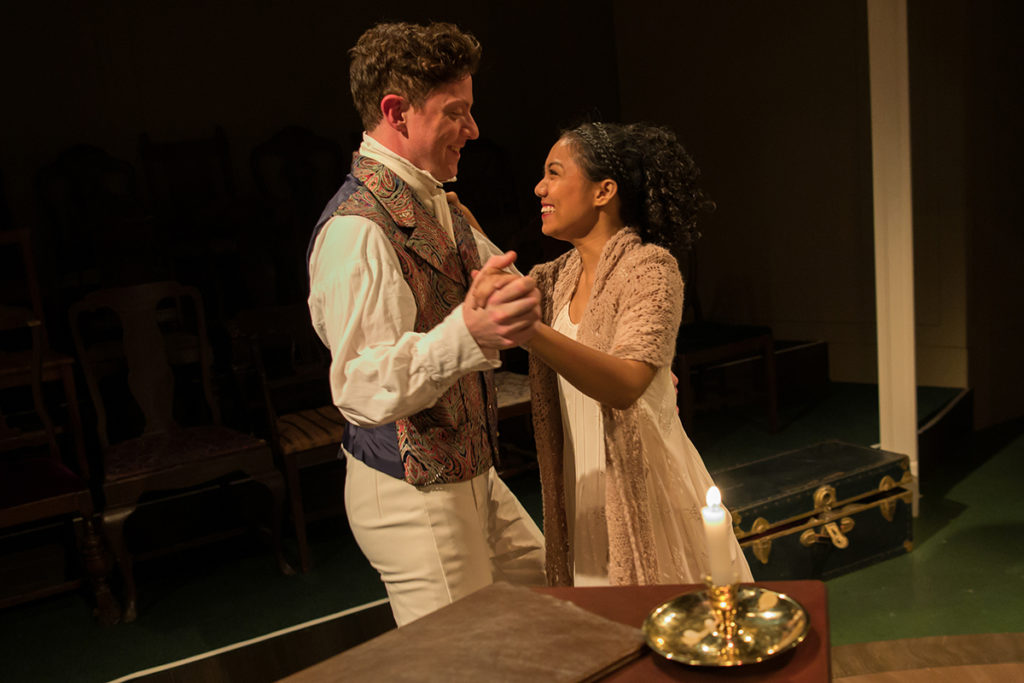
Max Forman-Mullin as Septimus Hodge; Amanda Ramos as Thomasina Coverly. All photos by Ben Krantz Studios.
Why is a Shakespearean writing about Stoppard?
An aside: My usual beat is early modern drama, especially Shakespeare, and although I like a lot of other plays and periods, I rarely write about modern drama. The reason for this is simply that the dividing line between pre-modern and modern drama is usually drawn at the advent of realism where plays suddenly start being about characters who are psychologically complex but generally inarticulate about their feelings and may not understand their own motivations.
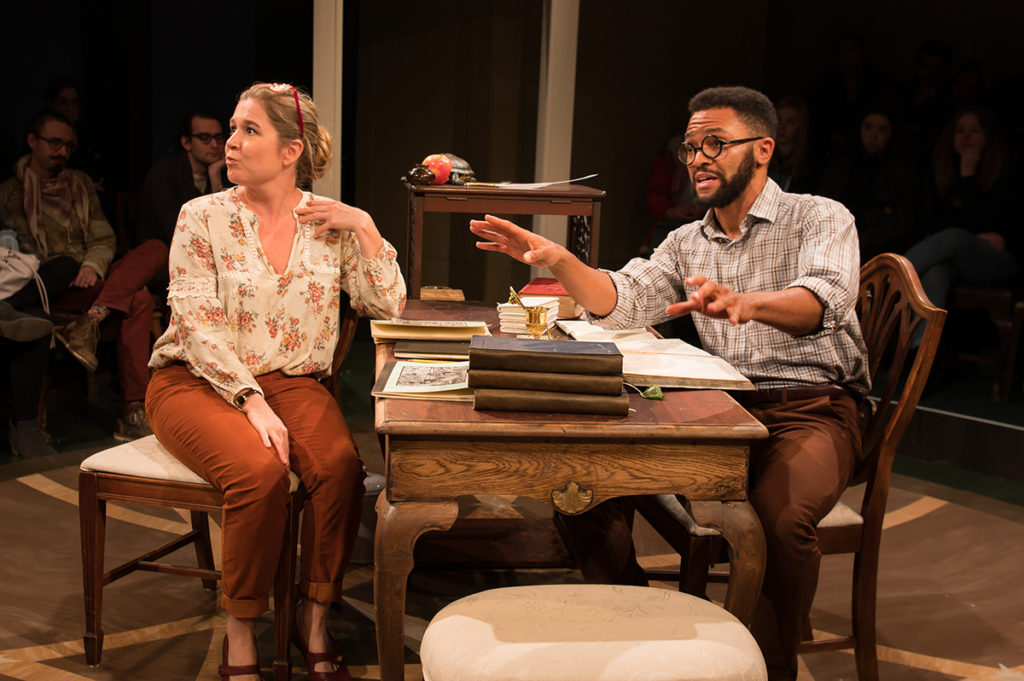
Jessma Evans as Hannah Jarvis, Gabriel Christian as Valentine Coverly; two characters in the modern scenes of the play who struggle to understand and express themselves.
My critical expertise falls on the other side of that line, with characters who are brilliantly (if unrealistically) expressive and articulate–to the point that they can sometimes put their thoughts into verse with healthy doses of rhetorical flourishes thrown in. In short, I write about performance of heightened language.
Usually the line falls more or less historically at the advent of the twentieth century, but in 2018, I saw two productions (both in Berkeley) of modern plays with linguistic brilliance that rivaled that of any classic. In the summer, Tony Kushner’s Angels in America at Berkeley Rep (with the amazing Stephen Spinella, the original Prior Walter, in role of Roy Cohn) was a–no pun intended–revelation.
A Small Theatre with Huge Impact
Surprisingly, given the very different level of resources available and invested, Shotgun Players’ late winter production of Arcadia was completely on par with the Rep’s Kushner. Shotgun’s company of exceptional actors, especially Max Forman-Mullin as Septimus Hodge and Amanda Ramos as Thomasina Coverly, invested in Stoppard’s non-stop wordplay (see what I did, or at least tried, there?) with wit, agility and stunning emotional honesty.
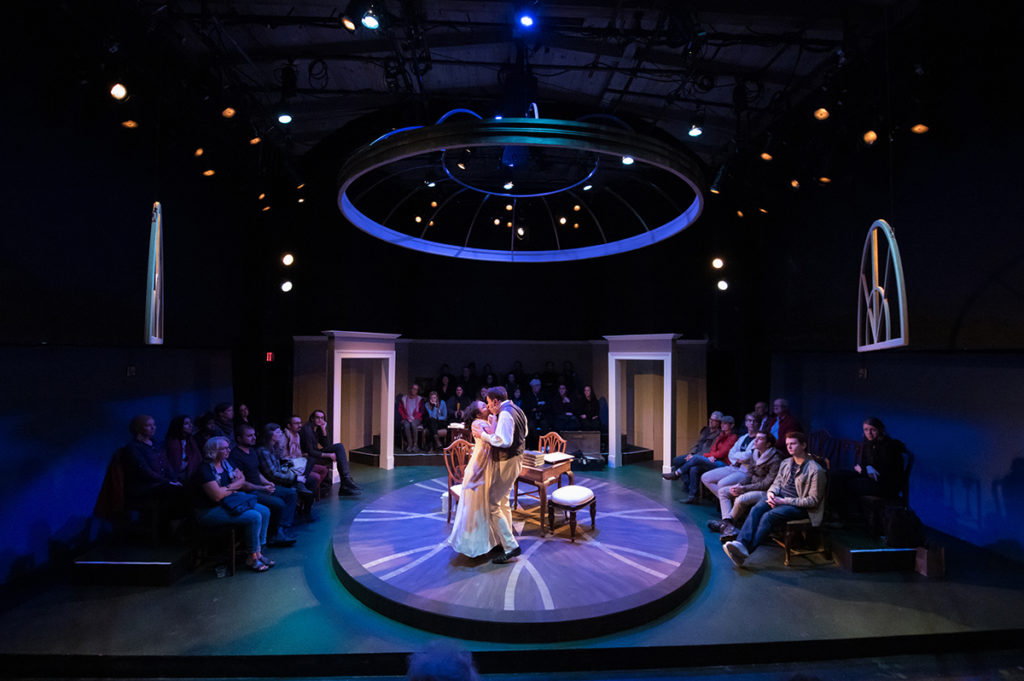
Amanda Ramos as Thomasina Coverly and Max Forman-Mullin as Septimus Hodge on Deanna L Zibello’s set with audience seated directly on the stage surrounding the players.
Patrick Dooley’s brilliant direction found every nuance in this incredibly complex plot and made it look easy, which I know from having directed this play myself, is not. In an extraordinary director’s note, Dooley emphasized the socio-political implications of the play beyond its dazzling theme and variations on love and lust, which brought even greater contemporary resonance to a play already considered a modern masterpiece.
Shotgun is a special place, and this production capitalizes on all their strengths. Their space is intimate, and made more so for this production. Rows of audience are set up on stage to create an arena staging, putting even more audience members right next to the action. The cast is as good as they have ever assembled, under their founding artistic director, who assembles very good casts. Most of all, however, is the experience of seeing this play with Shotgun’s loyal, and let’s face it, exceptional audience. The level of familiarity with this play and knowledge of the huge range of subject matters it deals with, from the history of English landscape gardening, to the poetry and personal exploits of Lord Byron, and on to modern fractal geometry, was astonishing.
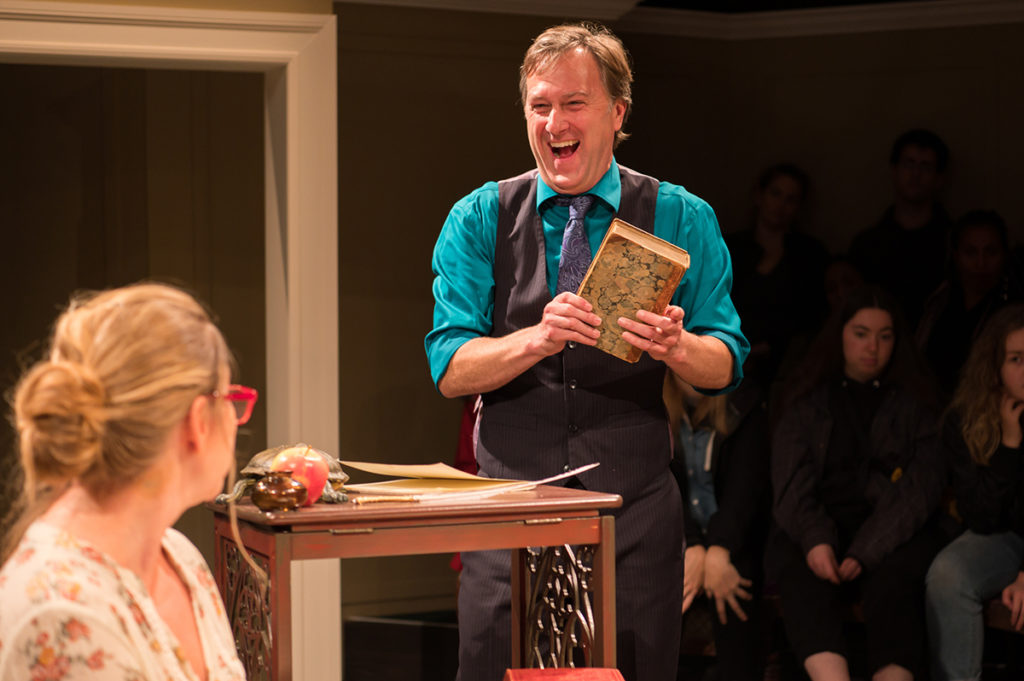
Aaron Murphy as Bernard Nightingale, a contemporary “expert” on Lord Byron.
(At intermission, an elderly couple seated next to me noticed I was making a few notes and volunteered to explain the convoluted plot to me. I accepted the offer without revealing that I knew this play very well already, and then got my comeuppance when they demonstrated, without the slightest condescension, that they actually knew it even better. It was a treat to hear their detailed and excited explication.)
Not just a Company, but a Community
A theatre is not just the artists and staff, it is also the community that they create. It is a different experience to see a play with an audience this receptive and perceptive–one to be relished. The play was sensitively interpreted by set designer Deanna L. Zibello’s minimalist arena aided greatly by the work of prop designer Devon Labelle, costume designer Brooke Jennings’ nicely coordinated period and modern costumes, lighting designer Sarina Renteria’s clever rendering of time, and Cliff Caruther’s sound design. I suspect that an unsung hero of the production might be dramaturg Dave Garrett.

Shotgun’s charming company photo, showing the complete cast and crew–emphasizing the collaborative nature of this company.
Get your year started right–go see this play. I assure you it will make you feel better about the times we live in, the state of the theatre, and the bright futures of some exceptional artists.
Production Information:
Arcadia is playing through Jan 27
Shotgun Players
1901 Ashby Avenue Berkeley, CA 94703
Tel: 510.841.6500
Website: shotgunplayers.org
Twelve Nights, Six Actors: A Review of TWELFTH NIGHT at the Arabian Shakespeare Festival
November 8, 2018 § 3 Comments
Shakespeare’s plays are undoubtedly great literature, but it is easy to forget that they are also amazing acting machines. The Arabian Shakespeare Festival’s current Twelfth Night is so full of virtuoso performances, including some very unexpected casting and doublings, that I am reminded again that when you bet big on the actors, small is beautiful.
This is ASF’s first foray into Shakespeare’s comedies, after a series of performances of tragedies I admired–especially a conceptually brilliant Othello in 2014. I was not sure how their house style and mission might adjust to this switch. Any doubts I might have had were almost instantly swept away by the sheer joy of playing exhibited by the charming, versatile and skillful cast of six.
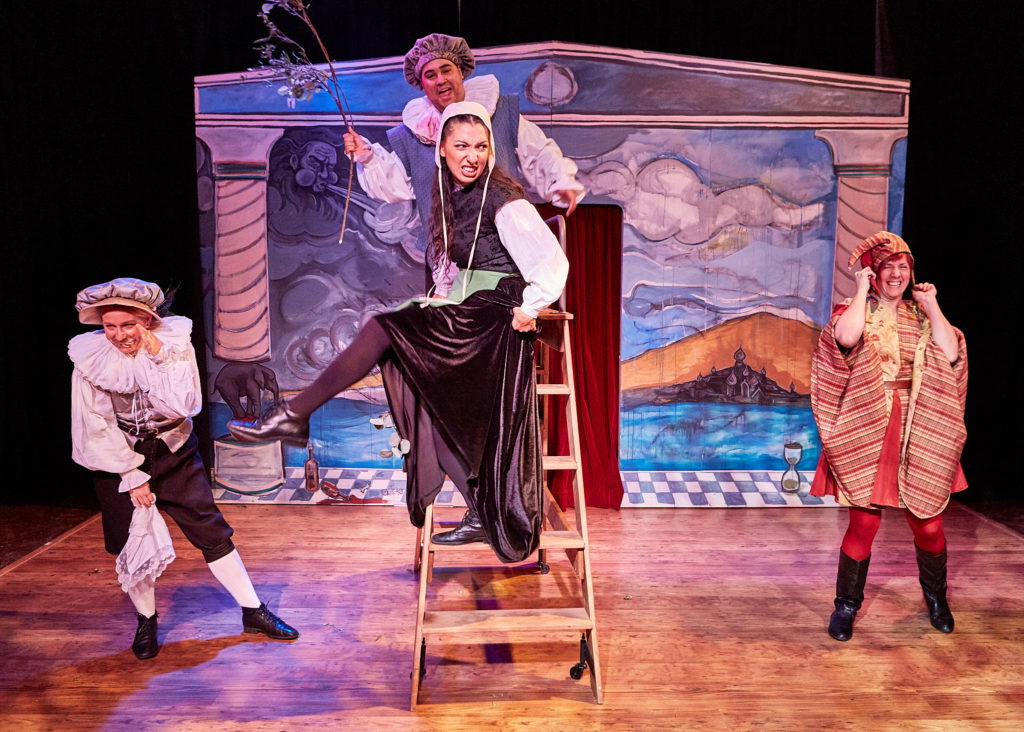
(l to r) Sir Andrew (Jennifer Le Blanc), Sir Toby (John R. Lewis), Maria (Livia Gomes Demarchi), and Feste (Rebecca Pingree) celebrate as their schemes come to fruition, in Arabian Shakespeare Festival’s production of Twelfth Night.
Layers of Delight
Twelfth Night is one of the middle comedies, with twenty roles in the cast list. I’ve seen wonderful productions of the play that were produced with a one actor/one role casting scheme. In these, the bittersweet story of a pair of separated twins (each believing the other lost at sea) who slowly work their way back to a reunion, the overthrow of a puritanical steward standing in the way of pleasure, and the surprising manner in which the courtship of a grieving countess by an admiring Duke ends in happily in marriage–just not to each other, was always satisfying. That is one layer of delight and it can be enough, in and of itself.
ASF’s production, insightfully designed and directed by Audrey Rumsby, sounds all those notes, but it has many more layers in play that make it much more than the sum of those parts.
Rumsby’s set design, echoing the central prop in the play, a toy theatre/music box, turns the Royce Gallery’s tiny playing space into a virtue. We know from her concept that we are seeing an imaginative romp. It invites us to think of the play as literal “play,” a game in progress. Elizabeth Smith’s whimsical costume designs capture the essence of each character, which is crucially important since actors quickly switch from one role to another with additions or subtractions of only a piece or two.
Thou Art Translated!
The cast uniformly delivers on the promise of this premise! John R. Lewis is a dignified and outstanding, if unconventional, Duke Orsino, but with the addition of a big, winestained ruff he transforms into Orsino’s antipode, the perfectly-named drunken reprobate, Sir Toby Belch. Watching him switch back-and-forth is enchanting above and beyond anything that he does in either role–a layer of pleasure that you don’t get in a conventional staging.
Rebecca Pingree raises the bar higher in her main role as the jester, Feste, as she demonstrates some serious musical chops in addition to her acting skills. (The whole production, in fact, is filled with excellent live music performed by the cast, under the musical direction of Lindsey Schmeltzer.) Very early on she doubles the usually forgettable role of the unnamed “Captain” in a surprisingly convincing masculine portrait, but reserves her comic firepower for a thoroughly confused (and confusing) priest in the play’s finale. She is terrific in all three parts.
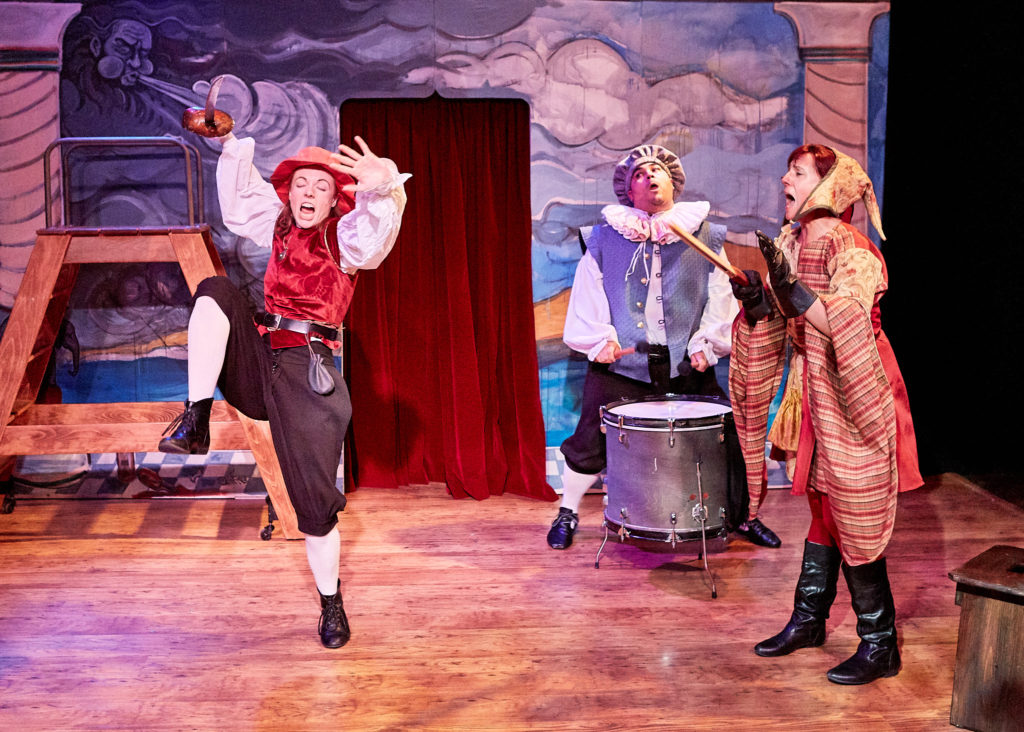
(l to r) Viola (Kate Rose Reynolds) prepares to fight a duel with Sir Toby (John R. Lewis), as Feste (Rebecca Pingree) look on.
Amelia Adams grounds her portraits of the male twin, Sebastian, and the insufferable puritan Malvolio in the physical techniques of Commedia dell’Arte. Neither role is realistically convincing, nor meant to be. (ASF could have cast a male actor, after all, if that was the goal.) Instead, both parts are suffused with deep observational insights about how we construct “leading men” and “the authority of male privilege” that can only be conveyed to an audience when they are obviously put on, instead of inherent in the actor.
Livia Gomes Demarchi plays two female roles at opposite ends of the “leading vs. character women” spectrum. As the Countess Olivia she is proud in declining the proffers of love from Duke Orsino but reduced to a quivering jelly in the presence of “Cesario,” whom she adores without realizing she is pursuing a disguised woman. As Maria, the pragmatic, scheming lady-in-waiting she is almost unrecognizable as the same actress although all that has really changed is the addition of a bonnet.
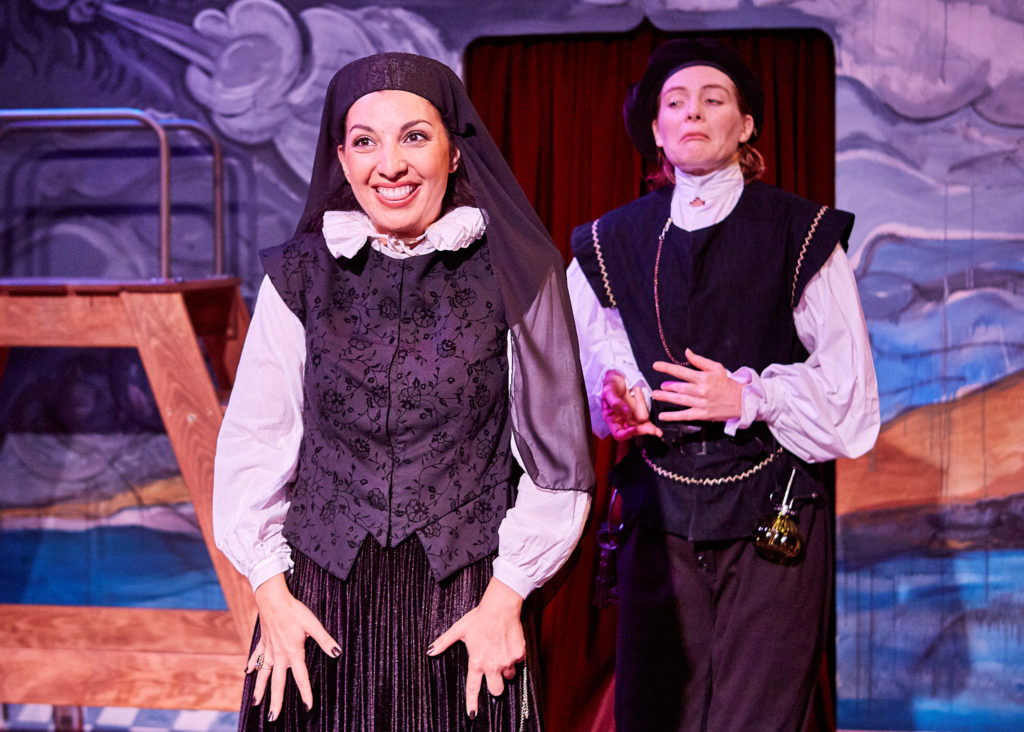
(l to r) Olivia (Livia Gomes Demarchi) reflects on her first meeting with Viola to her puritanical steward, Malvolio (Amelia P. Adams)
Kate Rose Reynolds plays the afore-mentioned twin-in-disguise, Viola/Cesario, (in both her female and male forms) with panache. This is the only “doubling” built into the play, and if it is unsurprising, it is no less entertaining because we see it in the context of a whole shape-shifting cast. I’ve seen an awful lot of “Cesarios” whose entire characterization appeared to be wearing a hat, but Reynolds seriously explores the mental transformation of her character when she assumes the male persona for protection. Hers is the most insightful Viola of my experience.
The actor in the announced cast with which I was most familiar previously was Jennifer Le Blanc, whose Desdemona for this company thrilled me. I was so disappointed to see that she would be playing two minor parts, neither of which seemed to me to make particularly good use of her talents: Sir Andrew Aguecheek, and the dedicated (probably lovesick) protector of Sebastian, the sea captain Antonio. I saved discussion of her performance for last, because I could not have been more wrong. She was astonishing–hysterically funny and heartbreakingly serious by turns–all night long. I found myself desperately racing ahead through the play’s scenes in my mind thinking about how soon I would see her again any time she left the stage. The virtuosity of the performances, of the transformations, and of the ensemble work was exemplary. Above all, her joy in playing the roles was palpable.
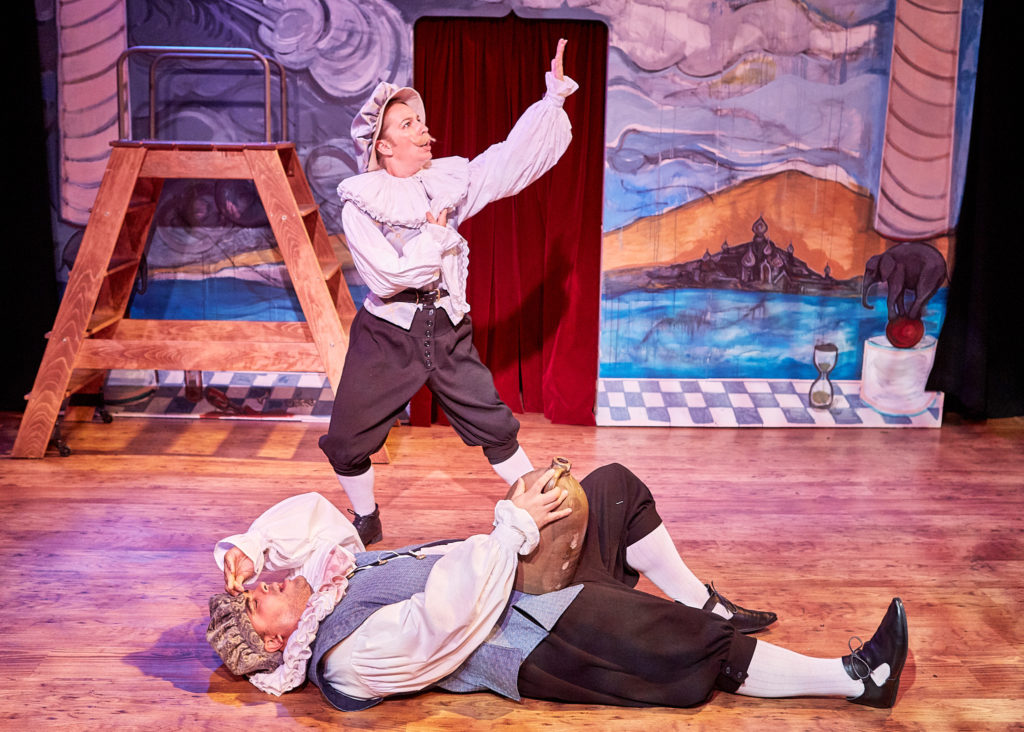
(l to r) Sir Toby (John R. Lewis) and Sir Andrew (Jennifer Le Blanc) drink and celebrate late into the night. All photos by Gregg Le Blanc of Cumulus Light Photography
The Means Are Limited but the Pay-off Is HUGE
ASF’s production is intimate. The space is small. The cast is reduced to just six players. The set and costumes are simple. The means are limited but the pay-off is huge. The play is actually MORE enjoyable because of the imaginative and versatile way that it is produced. I admire this company and have championed their work in the past, but now I have to say that as it matures it improves.
TL;DR
If you love Shakespeare, go see this production. If you love the theatre, go see this production. If you want to deeply understand why Shakespeare is the quintessential theatre artist, do not miss this production! There aren’t many seats. Get one while you can.
More Information
Twelfth Night – Nov.1–18, 2018, By William Shakespeare / Directed by Audrey Rumsby
Royce Gallery – 2901 Mariposa St., San Francisco, CA 94110
Online: www.ArabianShakes.org
By phone: 408-499-0017
This review is of the Sunday, Nov. 4 performance.
Brett Gamboa’s Brilliant Take on Doubling (and a lot of related stuff!) in Shakespeare
July 17, 2018 § Leave a Comment
This blog is concerned with the art of Shakespeare in performance, but the truth is that I review surprisingly few scholarly books here because it is frustratingly rare for one to perceptively address this issue. Now, however, there is a genuinely outstanding new book out that seems on its surface to be about a very narrow issue (doubling roles by actors in Shakespeare’s plays) and turns out to be about an entire range of performance issues that sneak in through that tiny crack. I recommend it without hesitation.
The book is Brett Gamboa’s Shakespeare’s Double Plays: Dramatic Economy on the Early Modern Stage. Professor Gamboa (of Dartmouth University) is the best kind of scholar-practitioner, and his book is essential reading for anyone seriously thinking about the plays in performance.
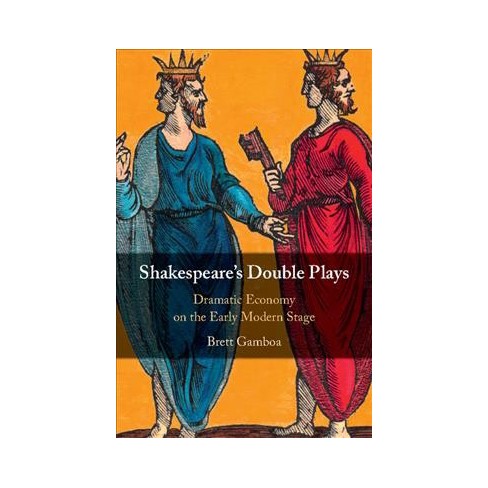
The cover of Gamboa’s new book
Gamboa’s book is a radical rethinking of the nature and significance of doubling (that is, an actor playing two or more characters in a production) in Shakespeare’s plays. His conclusions are startlingly original, and vastly different from the generally received ideas about how Shakespeare’s plays were performed in his own time and how they ought to be performed in ours.
Two Boards, a Dozen Actors and a Passion
Speaking with a practitioner’s voice, Gamboa flatly states that ALL of the plays in the canon can be performed by just 12 speaking actors, and are “more engaging, more pleasurable, sometimes even more credible” when they are. (Contrast this with, say, the New Oxford Shakespeare’s assertion that A Midsummer Night’s Dream, for example, requires a minimum of 12 adult males and an additional 10 apprentices/children because essentially no roles can be doubled in it, and you get a sense of how different Gamboa’s ideas are from even very recent scholarship on the subject.) He quickly disavows any ability to PROVE his thesis based on extant casting records or other historical evidence, but he is also quick to point out the myriad ways that the evidence does not support the generally accepted conclusions, either.
Gamboa, instead, argues very persuasively on aesthetic, dramaturgical, and practical grounds that the centrality of doubling to Shakespeare’s practice has never been properly explored, and its extent vastly underestimated. When combined with a critical reexamination of the historical evidence, he brings new insights into probable “original practice” and raises exciting possibilities for contemporary performance practice, training and production.
Along the way, he challenges a lot of standard narratives. He finds no reason to believe that Shakespeare and his fellow sharers, that is co-owners of the company, would refuse to play multiple parts in a production, however widespread the view has become in our time that the practice was confined to hired extras in small parts. He is equally dubious about the artistic and economic possibility of boy actors taking on major roles like Rosalind, Cleopatra and Volumnia after only a couple of years of training – or that there was a steady stream of apprentices (basically an entire stable of trainees) being maintained at all times to fill in for teenagers graduating to male roles as soon as their voices broke.
A much more likely scenario, given the evidence we have and our knowledge of the practical limitations on resources is that actors played females roles well into their twenties, that they sometimes doubled both male and female roles in a single production, and that these were highly skilled performances that depended on intentionally theatrical artifice rather than verisimilitude.
Beyond “Vulgar Necessity”
At the center of Gamboa’s argument, however, is not quibbling over whether theatre historians have overreached the evidence when putting forth their opinions. Instead, he focuses squarely on the compelling aesthetic patterns that emerge when doubling is not thought of as a “vulgar necessity” as one prominent scholar labeled it, but an integral practice for making meaning. His literary and theatrical insights are, well, thrilling.

Author Brett Gamboa
As but one example, he discusses how the Nurse’s otherwise inexplicable tirade on the death of Tybalt, in Romeo and Juliet, in which she calls him her best friend despite their having NO relationship in the play until that point, becomes meaningful in numerous new ways if we consider that the same actor might have played both parts. Among other things, it highlights the actor’s virtuosity to foreground the doubling, and provides another layer of pleasure to the audience when included in the “in-joke.”
If there only one or two such ideas in the book, it might feel like a stretch, but Gamboa is revelatory about every play in the canon, often highlighting numerous doubling possibilities that extend meaning through repetition or juxtaposition across multiple characters.
This is the most thoughtfully provocative book about Shakespeare’s practice I have read in years. It has enormous implications for how we train actors and directors, how we understand the dramaturgical structures of the plays, how we teach theatre history, and most of all, how we produce and perform the plays in our own time.
More Information:
Shakespeare’s Double Plays by Brett Gamboa
May 2018
Cambridge University Press
ISBN: 9781108417433
click ISBN for the Cambridge U website.
$99 from multiple retailers. E-book: $80
An Epic PERICLES at Marin Shakespeare
July 16, 2018 § Leave a Comment
Pericles is generally held to be minor Shakespeare. It was not included in the First Folio, has no reliable text, and was (according to almost all reputable scholars, who credit co-author George Wilkins) only partially written by the Bard. You never read it in school, and you only rarely get to see it. That is a pity, because – with some competent dramaturgy – it works wonderfully well in the theatre. Exhibit A is a delightfully emotional/entertaining production at Marin Shakespeare directed by Lesley Schisgall Currier and starring Dameion Brown in the title role.

Dameion Brown playing Pericles. All photos by Jay Yamada, courtesy of Marin Shakespeare.
Darkest before the Dawn
Pericles is one of the late plays, collectively labeled the Romances, which are generically tragi-comedies. (The others are The Tempest, The Winter’s Tale and Cymbeline.) These plays veer into the darkest of tragic places including the dissolution of the protagonist’s sanity and the apparent deaths of all he holds dear before reversing course and miraculously ending happily. If you get the tone wrong, they can seem manipulative and melodramatic, but if you get it right – and Marin Shakes gets it exactly right – they are indescribably moving. Currier finds the perfect balance of humor, sentiment and mythos to unleash the play’s power.
The play is too stuffed with incident to even attempt a plot summary, but this abundance of adventure, misfortune and eventual resolution is part of what makes it so alluring in the theatre. The action barely takes time to pause as Pericles’ epic journey races from one incident to the next, over decades and continents.
Double, Double…
The production uses a speaking ensemble of 10, many doubling and tripling roles in virtuosic turns. There is a not a weak link to be found, but Kathryn Smith-McGlynn is especially radiant as Thaisa and brilliantly hysterical as her polar opposite, the Bawd.
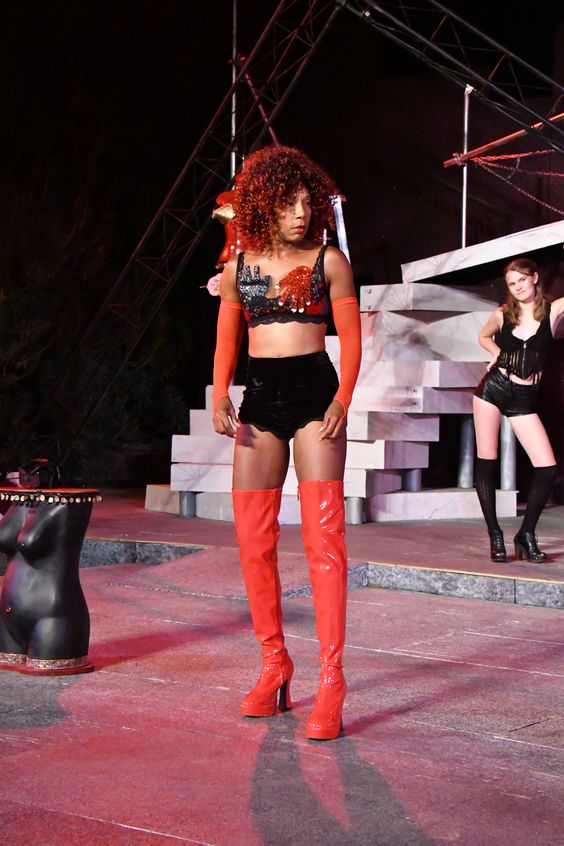
Kathryn Smith-McGlynn as the Bawd
Elena Wright perfectly sets the tone of the night as a petulant daughter to Antiochus, and is later stunningly commanding as the doctor, Cerimon.
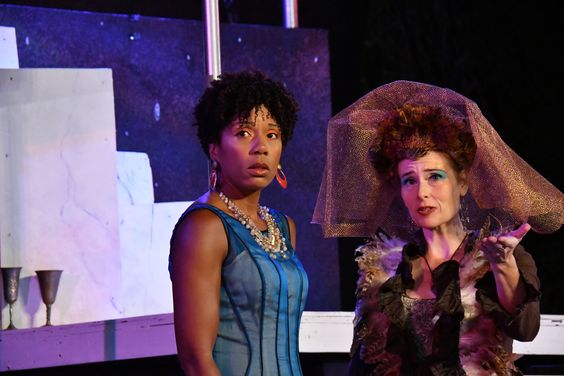
Smith-McGlynn as Thaisa and Elena Wright as Cerimon
It is hard to image any actor finding greater range in roles than the exceptional Rod Gnapp does with the heroic and noble retainer Helicanus contrasted with the relentlessly randy jack-of-all-trades in the brothel, Boult.
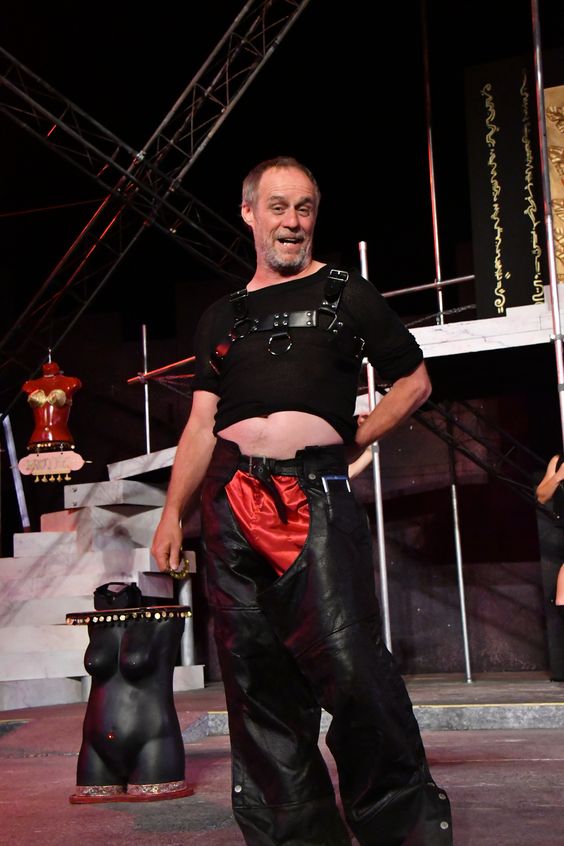
Rod Gnapp as Boult
The entire production is moved briskly along by Diane Wasnak in the role of the narrator, Gower. This is a difficult, and often thankless, role, but she handled it with such clarity and precision that I looked forward to her every appearance.

Diane Wasnak as Gower
At the heart of the production is the relationship between Pericles and the daughter he gave up in infancy and believes to have died in her teens before they could be reunited. The daughter, Marina, is beautifully played by Eliza Boivin. Brown is powerfully emotional all night long, but at his best in the extraordinary scene he shares with her near the end of the play.

Eliza Boivin as Marina with Dameion Brown as Pericles.
Brown is a phenomenon all his own. A former inmate at Salano State Prison, he was discovered and trained by director Currier in their Shakespeare-in-prisons program. Upon his release, he made his professional debut as Othello for Marin Shakespeare, winning a number of best actor awards in the Bay Area. Knowing this history, it is hard not to see the emotional depth in his performance as a man who believes he has lost everything only to find redemption and second chances after decades of misfortune. If you love Shakespeare, you’d be crazy to miss this performance, even if it had no other virtues than the realization of this beautiful scene. Of course, it does have other virtues, and lots of them!
This company is not spectacle oriented but Jackson Currier’s set design is suggestive of the cosmic scale of the epic play. Merissa Mann, the costume designer, has the unenviable task of costuming this play that requires literally hundreds of costumes. Those most central to the production are wonderfully executed but, unfortunately, in the production’s only real downside, many of the costumes for minor characters and extras seem chosen for their ability to be changed quickly and neither look good nor fit. Joel Eis’ props, by contrast are comically perfect.
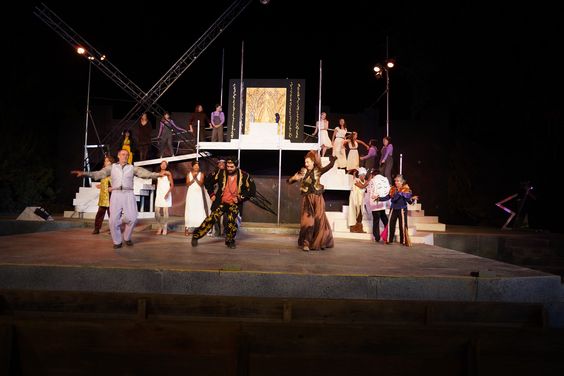
The cast on Jackson Currier’s set.
More Information
Pericles – July 14 – August 5, 2018, By William Shakespeare / Directed by Lesley Schisgall Currier
Forest Meadows Amphitheatre at Dominican University of California, 890 Belle Avenue, San Rafael, CA 94901
Performances at 8 pm Thursdays, Fridays, Saturdays and Sundays; and 4 pm Sundays. See website (www.marinshakespeare.org) for specific repertory performance schedule.
Phone: 415-499-4488
A Tale of Two Hamlets: A review of the Arabian Shakespeare Festival Production.
November 5, 2017 § Leave a Comment
At the center of the Arabian Shakespeare Festival’s current production of Hamlet are exceptionally insightful and original performances by William J. Brown III as the title character and Nathaniel Andalis as his bête noir and foil, Laertes. Without directly saying so, the production sidelines the more conventional antagonist, Claudius, with all-too-relevant implications.
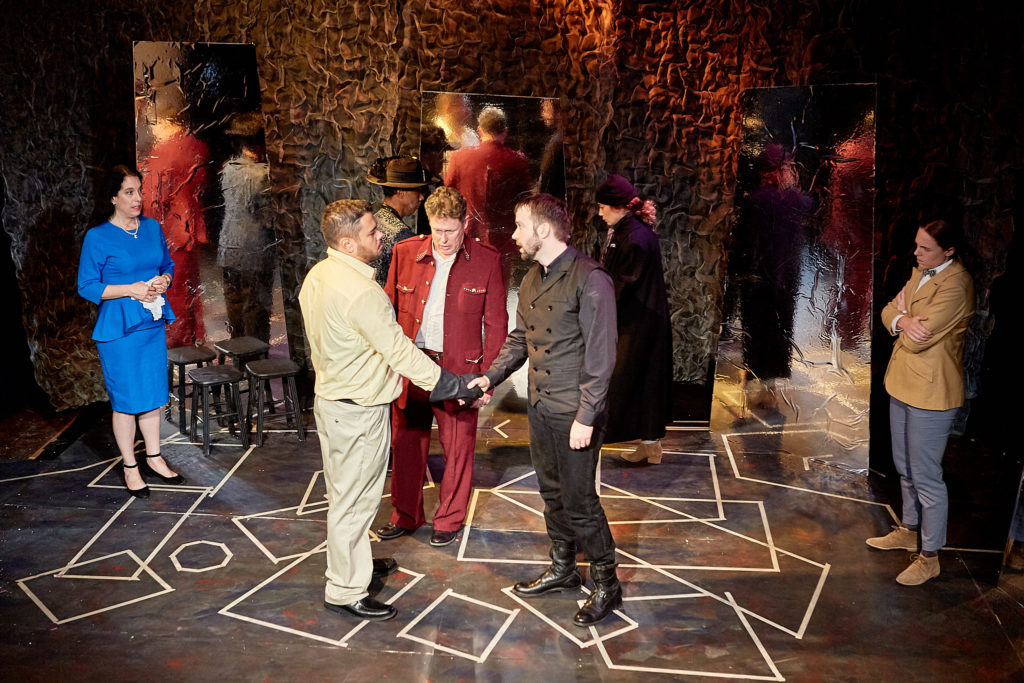
The cast of Hamlet, with Nathaniel Andalis as Laertes and William J. Brown III as Hamlet in the Foreground, John Flanagan as Claudius between them and Rachel Bakker as Gertrude, Norman Gee as Osric, Emily Keyishian as a courtier and Kate Rose Reynolds as Horatio looking on.
Hyperion to a Satyr
Of course, no play is thought to be so “universal” as Hamlet, so it is no surprise that any reading seems somehow current. Nonetheless, a focus on Hamlet’s disgust at the weakness of the current leader in comparison to his immediate predecessor, and his incredulity that anyone (let alone everyone) fails to see it, is so pregnant with contemporary implications that the production positively boils with renewed urgency.
John Flanagan plays Claudius as a weak and self-important ruler, so it is instantly believable when the play reveals he sleazed (rather than powered) his way into the job. Hamlet is too well-known for Claudius’ guilt to surprise anyone, but in this case, the production dwells on the patient investigation necessary to bring it into the open. Something IS rotten in Denmark, and everyone knows it, but out of pure self-interest no one will be the first to say so.
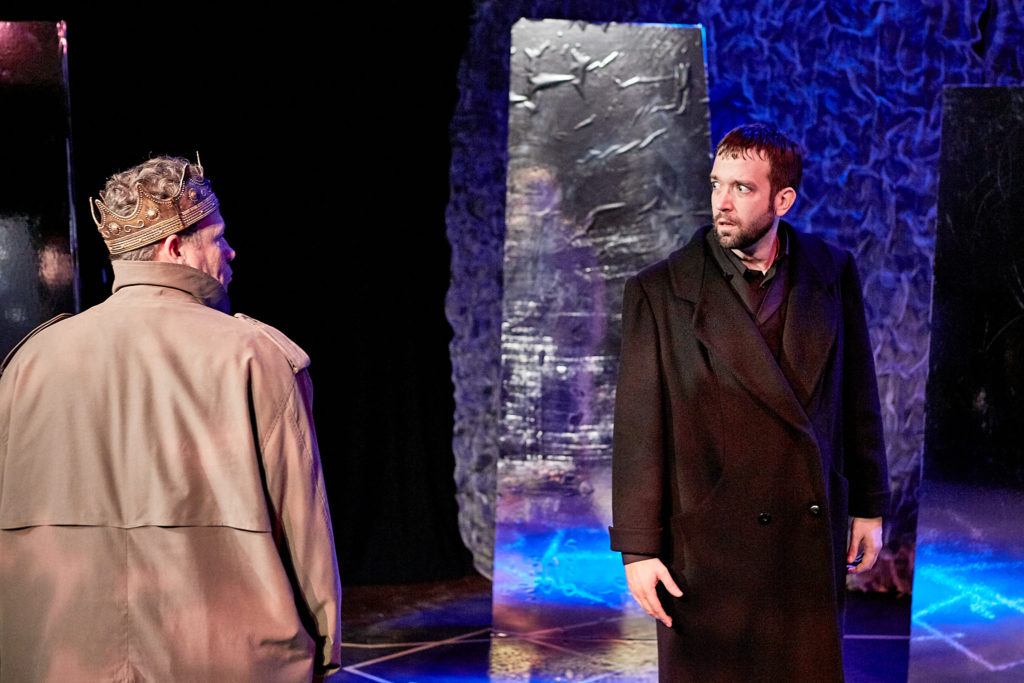
William J. Brown III as Hamlet, with John Flanagan as the Ghost. Photos by Gregg Le Blanc.
O Cursèd Spite!
Brown’s Hamlet is the opposite of the traditional conflicted and dithering naïf. This Hamlet is on the edge of rage from beginning to end. He has to fight for control of his passions, and struggles to apply the rationality he knows the situation demands if he wants justice and not just revenge. Brown is an exceptionally intelligent actor. His delivery of Hamlet’s famous soliloquies is slow and meticulous, but only because his Hamlet is so obviously forcing himself to reason through circumstances where he would rather rampage.
In this production the most powerful counter-force is Laertes who, like Hamlet, is another seeker of revenge for his father’s murder. Interestingly, the actor in this role is Nathaniel Andalis, who spent his summer playing the title role for the San Francisco Shakespeare Festival. Andalis is a charismatic performer with exceptionally deep connections to this play. (His bio says that he hopes to play all the roles in the play eventually, and in this production he is half-way to meeting this goal by notching up his seventeen role in the show.) Laertes exists in the show as a “foil,” a subsidiary character whose situation mirrors that the protagonist so that we might see both comparisons and contrasts. I’ve never seen this function so fully executed as it is in the performance Andalis delivers. I attribute this to the fact that he so deeply understands exactly how the role illuminates that of Hamlet, emotionally and thematically, because he brings such deep perception of the title role from his own experience of playing it. In a way, in this production you get to see two Hamlets – and they are both compelling. Placed in opposition to each other, they are explosive.
The company was rounded out by Rachel Bakker as Gertrude, Norman Gee as Polonius, Emily Keyishian as Ophelia, and Kate Rose Reynolds as Horatio. (All four also played several other parts.)
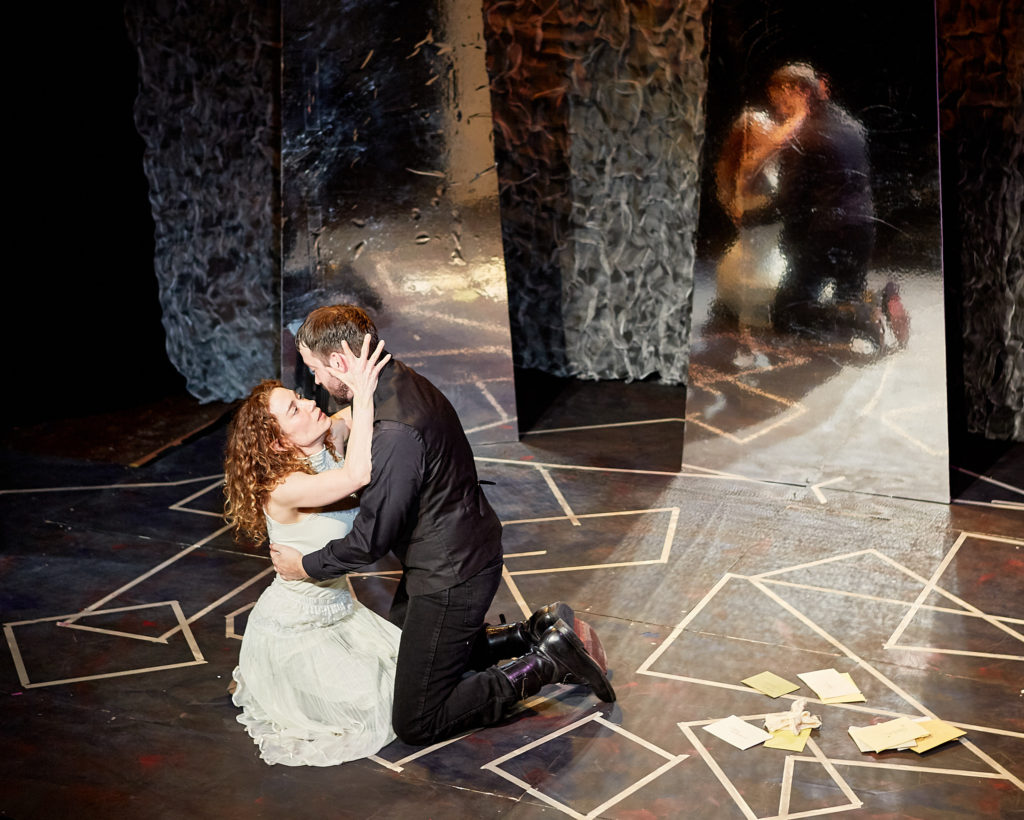
Brown as Hamlet with Emily Keyishian as Ophelia on Malcolm Rodgers reflective set.
A Great Reckoning in a Small Room
I am on record as a big fan of this small but interesting company. A couple of years ago they produced an Othello that thoroughly explored the title character as an Arabian Moor that opened completely new aspects of the play for me. Both pre-show publicity and program notes suggest that this Hamlet is also filtered through an Arabian viewpoint – although I do not think this displays overtly or that this information is necessary to appreciating their effort. The play, in fact, seems particularly relevant and compelling for reasons (outlined above) that seem far from the Arabian traditions of political revenge tales that it might be referencing. The obvious political implications as well as the preciseness of the investigation of revengers (in this case doubled because the Laertes is rendered as specifically as the Hamlet) is what makes this production unique.
The production is staged by Kevin Hammond, whose work tends to emphasize striking individual moments that don’t always cohere into a big picture. Some of those moments, however, (especially Hamlet’s encounter with Claudius at prayer) are stunningly effective and thought-provoking. Hammond’s greatest contribution was the dramaturgy of the production: The text was both abridged and intriguingly rearranged (into almost collage fashion).
Malcom Rodgers’ minimalist, mirror-laden set was evocative. Matt Stines’ sound design was subtle but brilliant. Patricia Tyler’s costumes, by contrast, were pedestrian and insistently realistic in a production that was otherwise built on theatrical convention. (The production is performed by seven actors jumping quickly in and out of multiple roles.)
The highlight of the night was the exceptional fencing match-turned-duel at the end of the play, choreographed by Andrew Joseph Perez. The fact that we were right on top of it in the tiny (40 seat) Royce Gallery contributed to the sense of danger, but such immediacy worked in the play’s favor here, and throughout the show.
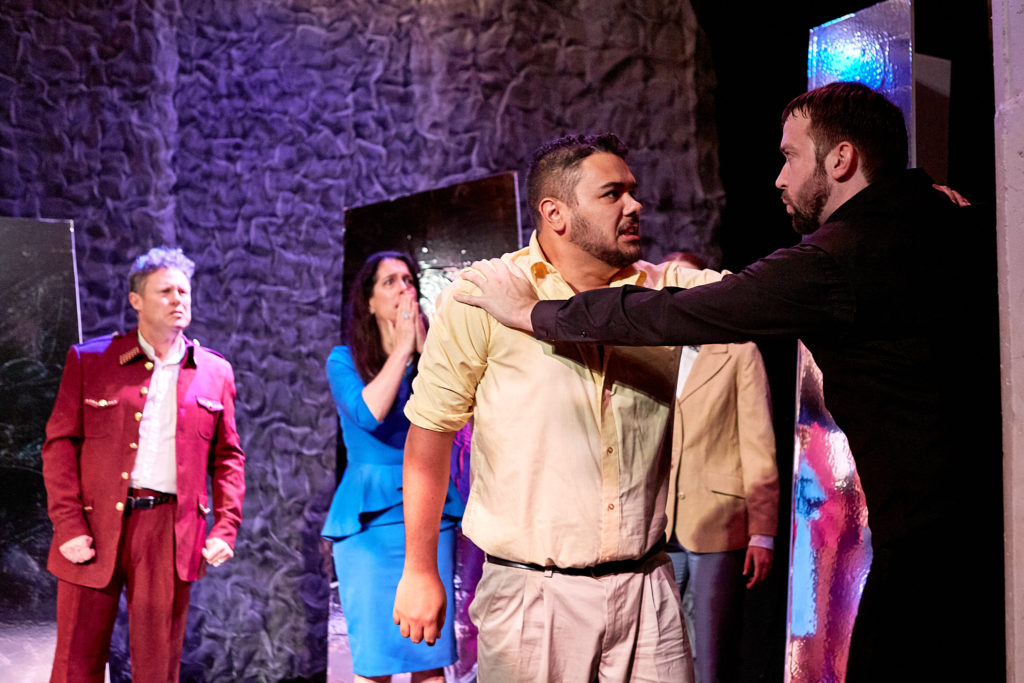
Nathaniel Andalis as Laertes and William J. Brown III as Hamlet (with cast members looking on)
Hamlet has a limited run, and there are few seats. If you love this play, this is an interpretation you don’t want to miss, with two stellar performances that you shouldn’t miss. See it while you can.
This article has been updated to credit director Kevin Hammond with the dramaturgy, and to include additional photos.
This review is of the Nov. 3 performance.
More Information
Hamlet plays through November 19th
(Thursdays- Saturdays at 8pm & Sundays at 2pm)
Royce Gallery (2901 Mariposa St., San Francisco, CA 94110).
Visit www.arabianshakes.org for tickets and more information.
What’s Your Problem?: A Review of MEASURE FOR MEASURE at CalShakes
September 27, 2017 § Leave a Comment
Measure for Measure, Shakespeare’s rhetorically brilliant but generically ambiguous “comedy,” is perpetually a problem. Tyne Rafaeli, directing for co-producers, the California Shakespeare Theater (CalShakes) and Santa Cruz Shakespeare, provides a fascinating approach that does not “solve” the difficult text (and in some ways complicates it even further) but does provide a set of visual tableaus and cleverly staged moments that make it especially relevant to the Bay Area audiences and the fraught political moment in which we live.
Why the play is so difficult is no particular mystery. Shakespeare adapted a completely tragic story (from the same source that he used for Othello) then – through the addition of a couple of hoary plot devices – restructured it into a comedy. Although everything does work out in the end, the tone of the play remains predominantly dark, however, so it is hard to know how lightly to take it and what to make of the moral dilemmas it poses.
Power and Perversion
The convoluted plot is the story of a Duke who is reluctant to exercise his power to maintain order, and so temporarily turns his duties over to a puritanical deputy with no such qualms. To set an example, the replacement ruler immediately sentences a young man to death for the relatively minor crime of impregnating his fiancé before marriage. The young man’s sister (a novice on the verge of taking her vows to become a nun) makes an impassioned argument for his life, which perversely just excites the cold deputy’s lust. He propositions her, offering the brother’s life in return. Faced with what is known in literature as the monstrous bargain she refuses. “More than our brother,” she declares, “is our chastity” – a position that modern audiences, at least, do not always find sympathetic.
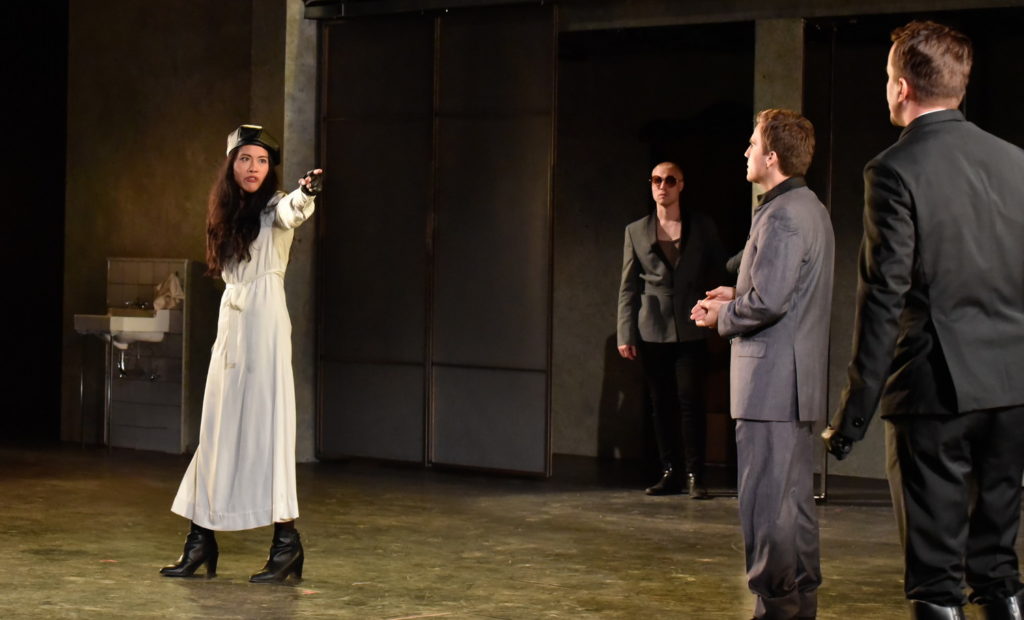
(L to R) Lindsay Rico (Isabella), Adam Schroeder (Lucio), Rowan Vickers (Duke) and David Graham Jones (Angelo) in California Shakespeare Theater’s MEASURE FOR MEASURE, directed by Tyne Rafaeli; photo by Jana Marcus.
Oddly, the Duke is lurking about in disguise and convinces the heroine to pretend to assent, and then substitutes the deputy’s rejected fiancé in the darkened bedroom. In a not-all-that-shocking twist the deputy, even though he is fooled by the substitution, still orders the execution to go ahead. The Duke has to struggle around in the background to prevent tragedy, and eventually resumes his position in order to set things right – just not until after he has convinced the young man that will have to die, convinced his sister that he did die, and convinced the hypocritical underling that he got away with it all. (Although manipulative, it is probably supposed to have a Big Yellow Taxi effect.) By the time the ending comes, when the Duke proposes to the would-be nun, the audience has been bounced between the poles of starkest tragedy and melodramatic relief several times.
Visualizing Psychology
Rafaeli imbues her production with an artificial urgency throughout, which makes it all look and feel much more like a farce. This certainly reduces the tonal whiplash we usually experience in productions of this title – but also rushes the detailed explanations of what is happening (and why) to the point that it is often far from clear to anyone not already familiar with the play what is transpiring.
What is genuinely original, and pretty wonderful, about the production is how Rafaeli makes many of the most difficult assumptions in the play more comprehensible through striking visual compositions. She stages the propositioning scene as a graphic sexual assault, sending the heroine initially into frozen shock – a haunting tableau that sums up the abuse of power and the helplessness of victims in a single image. Isabella’s subsequent revulsion at the idea of having sex, even to save her brother’s life, becomes psychologically comprehensible. (Given that we are living under a happily “pussy-grabbing” president, it also makes it inevitably political.)
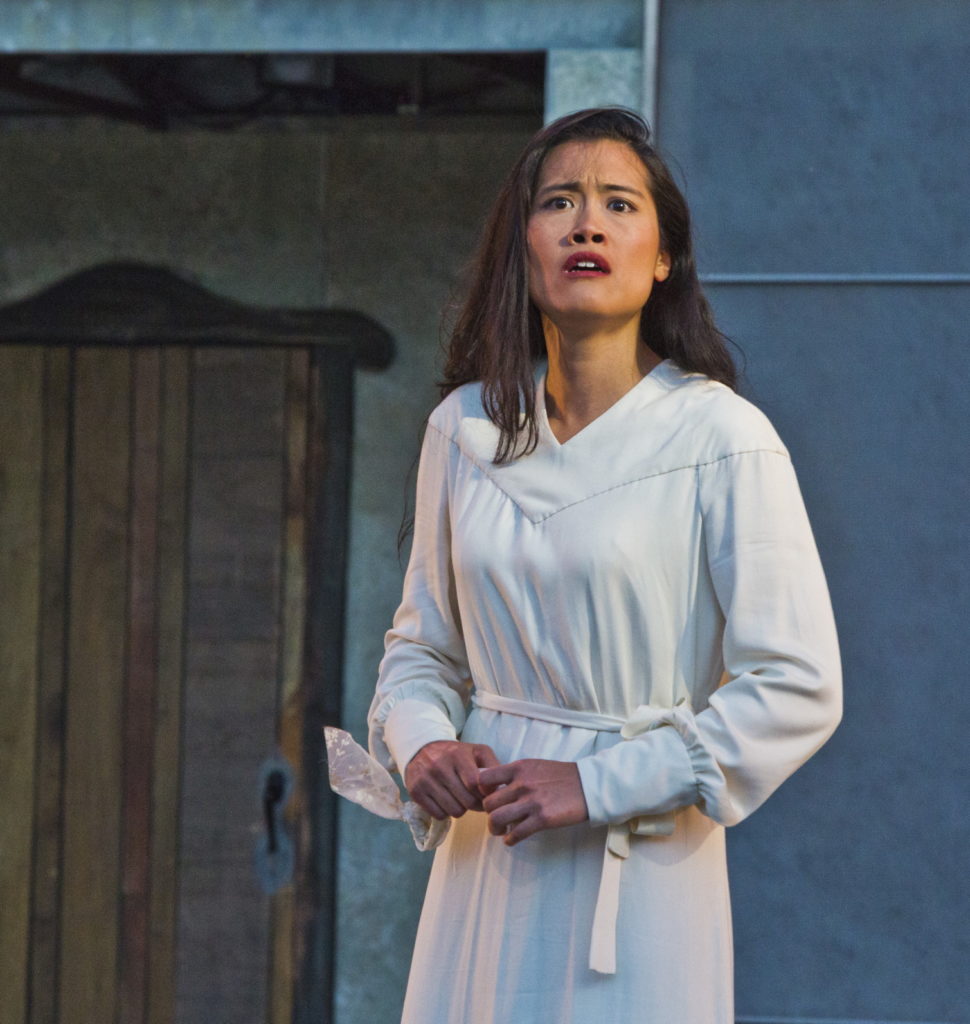
Lindsay Rico (Isabella) in California Shakespeare Theater’s MEASURE FOR MEASURE, directed by Tyne Rafaeli; photo by rr jones.
Her brother, whose punishment vastly outweighs his crime, is played by an actor of color. Rafaeli’s staging of his scenes of imprisonment with starkly contemporary details to the cell is surely meant to remind us of the injustices of our current system that disproportionately imprisons black and Latino men. A stumbling block for many Measure for Measure audiences is often that they find the overly-harsh sentence silly instead of serious, but in Rafaeli’s context it is all too plausible – again speaking to both the local audience and current moment.
A Different Kind of Setting for CalShakes
Throughout the play, Rafaeli uses the broad, shallow setting to create quick visual snapshots of important moments that remind us of nothing so much as eye-popping comic book panels freezing the action into bold compositions. Although wide and flat, Annie Smart’s set is both functional and effective for this purpose. It is very unlike the usual stage sets in CalShakes’ outdoor location where seeing into the far distance is possible. Montana Levi Blanco’s modern dress costumes often border on the whimsical. It is Kent Dorsey’s lighting that ultimately makes Rafaeli’s visual summaries burn into our consciousness.

Adam Schroeder and Annie Worden in Montana Levi Blanco’s fantastical costumes.
There are No Small Parts
To achieve the contemporary resonance, both verse speaking and self-conscious rhetoric were sacrificed to more physical approaches. As a result, the small players were often the most interesting members of the cast, especially Annie Worden’s rapid-fire turns as the Mistress Overdone, the Dogberry-like constable Elbow, the belligerent drunk, Barnadine, who farcically refuses to be executed, and Mariana, the heartbreakingly rejected fiancé of the false deputy who finally reclaims him from his own hypocrisy. CalShakes favorites Tristan Cunningham and Patty Gallagher also produce compelling and varied performances across a number of roles, as does newcomer Kevin Matthew Reyes as the brother, Claudio, and his polar opposite, the amusing pimp Pompey.
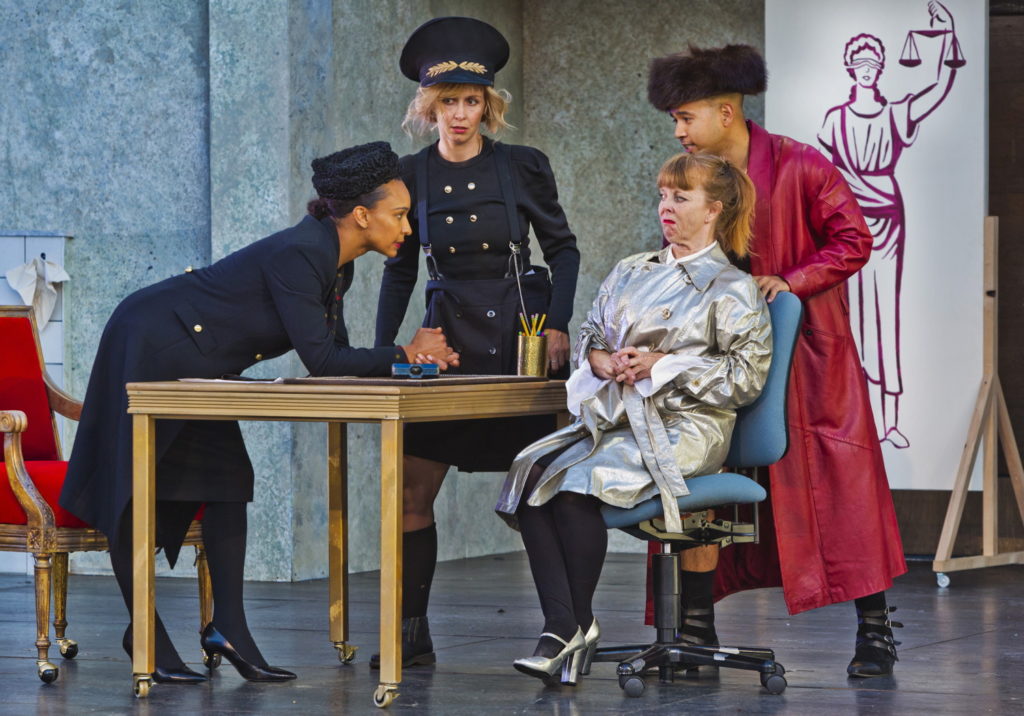
(L to R) Tristan Cunningham (Escalus) and Annie Worden (Elbow) question Patty Gallagher (Froth), and Kevin Matthew Reyes (Pompey) in California Shakespeare Theater’s MEASURE FOR MEASURE, directed by Tyne Rafaeli; photo by rr jones.
In the end, this production was a reminder that there is no such thing as a definitive staging of any Shakespeare play. There are endlessly fascinating possibilities, however. Measure for Measure is often a showcase for exceptional voices and fine verse speaking. It is almost unique to see it staged as a director’s vehicle emphasizing visual pictures and physical comedy. It is hard for me to remember any production of this show that was so closely tuned to place and time in which it was presented.
America’s Most Produced Playwright, 2017-18 edition: Yep, Still Shakespeare
September 24, 2017 § Leave a Comment
Once again, American Theatre magazine lists of most produced plays and playwrights are out.
Every season, Theatre Communications Group (TCG) – the organization of America’s not-for-profit theatres – puts out a list of the 10 most produced plays, and top 20 playwrights by its nearly 500 members. Although it covers only a segment of the American theatre scene, (because it does not include for-profit, academic, or amateur theatres) its annual lists are a quick way to get the pulse of what plays and playwrights are currently hot. That is a very useful list for performers thinking about where to put their time and energy familiarizing themselves with scripts, with names to watch, and with sources for audition material.
Who tops the list this year? The most produced playwright in America next year will be:
With a total of 108 productions scheduled, our winner, William Shakespeare!

Only, as always, you have to read the footnotes to know that. Shakespeare so dominates this list year-after-year that American Theatre’s editors do not officially count him. (You can read my previous annual rants on this topic, here, here and here.)
To note this fact is not to take anything away from this year’s “winner,” San Francisco-based playwright Lauren Gunderson. For the third year in a row she has been in the top ten list without having a major New York production, and relying on an extensive body of work rather than a single standout title. (It is also worth noting that several of her comedies, like Exit – Pursued by a Bear, The Taming and The Book of Will, have Shakespeare connections.)
BUT…for those who are counting there will 108 productions in America’s professional theaters of Shakespeare’s plays, vs. 27 by Gunderson. Shakespeare, in fact, has more productions scheduled than the top five “official” finishers combined.
As I try to remind my students regularly, if they are trying to decide where to put their time and energy, they would do well to place their emphasis on Shakespeare.
Oh, and one more thing. Next year’s most produced individual play? No, it is not by Shakespeare – but it is about him: Shakespeare in Love is set to receive 15 productions.
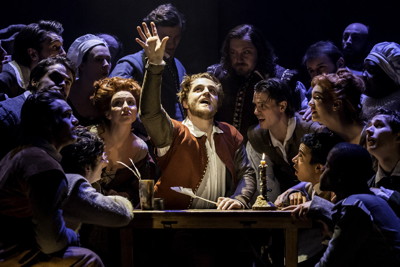
Orlando James (Will Shakespeare) in Shakespeare In Love at the Noel Coward Theatre in the original London production
